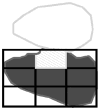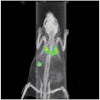Vagal control of mucociliary clearance in murine lungs: a study in a chronic preparation
- PMID: 20051324
- PMCID: PMC2844898
- DOI: 10.1016/j.autneu.2009.12.002
Vagal control of mucociliary clearance in murine lungs: a study in a chronic preparation
Abstract
We conducted several experiments that focused on the effect of vagal control on mucociliary clearance (MCC) in murine lungs. We hypothesized that loss of vagal control by chronic denervation (i.e. vagotomy) would reduce both basal MCC and the increase in MCC typically observed upon stimulation of capsaicin sensitive C-fibers. Vagotomy was performed on the right side of C57BL/6 mice and MCC was measured 5 days later. Mucociliary clearance was measured by gamma scintigraphy after oropharyngeal aspiration of the radioisotope (99m)technetium and was expressed as the amount of radioactivity removed from the right lung 6h later. Baseline MCC was unaffected by vagotomy, averaging 6.5+/-4.9% and 6.8+/-5.8%, in 6 vagotomized and 6 non-vagotomized mice (controls), respectively. Mucociliary clearance increased significantly to 12.7+/-5.9% in 9 non-vagotomized mice treated with 1.6 x 10(-9) M capsaicin, a vagally-mediated, nociceptor stimulus (p=0.041). Capsaicin was admixed with (99m)technetium and administered by oropharyngeal aspiration. In contrast, MCC was unchanged from control values in 9 vagotomized, capsaicin-treated animals, averaging 6.0+/-5.5% (p=0.024). These findings suggest that loss of vagal control through denervation does not affect basal MCC in C57BL/6 mice, but does appear to reduce the capacity of mice to respond to nociceptor agents that stimulate MCC. These data could have implications for patients whose lungs are denervated due to lung transplantation, since they may be at risk for an inadequate MCC response to inhaled irritants and inflammatory mediators, which are also nociceptor stimuli.
2009 Elsevier B.V. All rights reserved.
Figures




References
-
- Anderson WD. Thorax of Sheep and Man: An Anatomy Atlas. Dillon; Minneapolis: 1971.
-
- Alton EWFW, Khagani A, Taylor RFH, Logan-Sinclair R, Yacoub M, Geddes DM. Effect of heart-lung transplantation on airway potential difference in patients with and without cystic fibrosis. Eur Respir J. 1991;4:5–9. - PubMed
-
- Bennett WD, Olivier KN, Zeman KL, Hohneker KW, Boucher RC, Knowles MR. Effect of uridine 5′-triphosphate plus amiloride on mucociliary clearance in adult cystic fibrosis. Am J Respir Crit Care Med. 1996;153:1796–1801. - PubMed
-
- Borthwick DW, West JD, Keighren MA, Flockhart JH, Innes BA, Dorin JR. Murine submucosal glands are clonally derived and show a cystic fibrosis gene-dependent distribution pattern. Am J Respir Cell Mol Biol. 1999;20:1181–1189. - PubMed
-
- Donaldson SH, Bennett WD, Zeman KL, Knowles MR, Tarran R, Boucher RC. Mucus clearance and lung function in cystic fibrosis with hypertonic saline. N Engl J Med. 2006;354:241–250. - PubMed
Publication types
MeSH terms
Substances
Grants and funding
LinkOut - more resources
Full Text Sources

